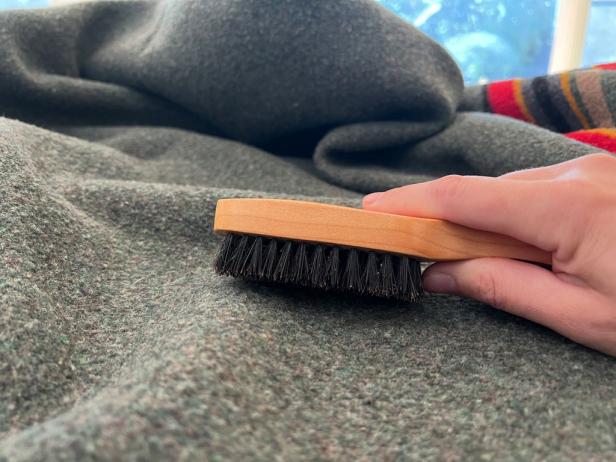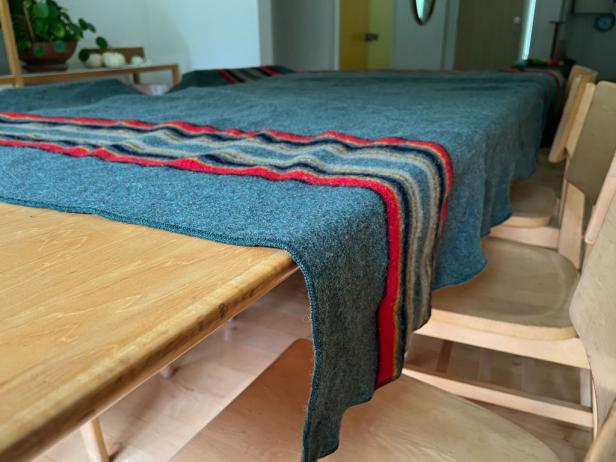How to Wash a Wool Blanket
Cleaning wool isn't as risky as you think. Take care of your wool blanket, and it’ll love you back for a long time.

Wool has suffered a stigma over time, namely because it comes across as being high-maintenance and difficult to launder; you can thank hyper-cautious manufacturer laundry labels for that. On the contrary, it isn't high-maintenance and isn't difficult to clean. You don't even need to take it to a dry cleaner. But you do need to be careful; don't treat your wool blanket the same way you treat a fleece throw.

Emily Fazio
Wash a chunky knit blanket without shrinking or felting it.
With a little know-how, you'll find that it's actually pretty easy to wash wool without destroying it — and you might be surprised to learn that it's totally OK to put your wool blanket in the washing machine! What matters most is the type of detergent you use, the temperature of the water and the wash setting.
Unlike synthetic fibers, wool has both antibacterial and antimicrobial properties. Your wool blanket simply doesn't need to be washed often. In fact, you might go an entire season without cleaning your wool blanket, and that's OK! If it seems like it needs to be cleaned, it may just need to be aired out. Draping it to expose the fibers to fresh air is a great way to extend time between wash cycles. But when it does need spot cleaning or you're ready to wash it before putting it in seasonal storage, follow these steps to learn how to wash and dry your wool blankets.
You’ll Need:
- enzyme-free detergent formulated for wool and delicates
- soft-bristle brush
- absorbent cotton cloth
- cold water
- mineral spirits (optional - for oily stains)
- rubbing alcohol (optional - for coffee or wine stains)
- white vinegar (optional - for blood stains)
- white towels
- large, flat drying surface
- shaded clothes line

Emily Fazio
Use a soft-bristled brush, like a hair brush, to loosen dirt on a wool Pendleton blanket.
1. Loosen Embedded Dirt
- Use a soft-bristled brush to gently dust across the surface of the wool blanket, wiping in one direction. Avoid scrubbing. The goal is to agitate the surface so embedded particles fall free when the blanket is shaken out.

Emily Fazio
Treat dried stains on a wool blanket before washing.
2. Spot Clean Stains
Wool fibers do stain easily, so it's really important to clean stains while they're fresh. Try to eliminate as much of a stain as possible before washing a blanket in the machine. There are a few easy methods to clean wool based on the type of spill or stain:
- Rinse fresh stains with cold water. Spilled wine, coffee or fruit juice? You can saturate the stain right under your kitchen faucet. Avoid scrubbing, but try to help clear the fibers. If you catch the stain before it dries, you have a very good chance of rinsing it out.
- Remove hardened stains. For solid stains, such as chocolate melted into the fibers, remove as much of the material as you can before applying a cleanser. You can gently pry at the wool with a spoon without damaging the fibers.
- Apply a cleanser to the stain. For dry or oily stains (makeup, for example), dab at the stain with mineral spirits on a white cotton cloth. This will help dissolve and lift the oils. For liquid stains that have dried, apply a wool-friendly cleaner. Mix a small amount of cold water with wool shampoo or delicate detergent. You can apply this directly to the stain with a soft cotton cloth. After letting it sit for a few minutes, rinse the area with cold water until the cleanser is removed.
- Try tougher stain removers. If the wool-friendly detergent doesn't have enough oomph for a stubborn stain, there are other options, but you should use them sparingly (not over a huge area of your blanket). A 3:1 mixture of rubbing alcohol and water can help soak into wine and coffee stains to treat the fibers. Undiluted white vinegar applied directly to wool can help loosen dried blood stains.

Emily Fazio
Avoid overfilling the washing machine when laundering a wool blanket.
3. Put the Blanket in the Washing Machine
By this point, you might have cleaned your blanket sufficiently by spot cleaning and air drying, but taking a trip in the washing machine a few times a year won't hurt it if you are careful. Most people fear damaging the fibers irreversibly, but you can successfully wash a blanket without shrinking it if you choose the right detergent, water temperature and wash settings.
- Use only wool-formulated delicate detergent.
- Use only cold or tap-water temperature. Technically, wool can be washed in warm water, but only if there is no agitation. You're better off not risking it.
- Use only a delicate/wool washing machine setting with low spin. Washed in cold water, the wool can withstand a light spin in the washing machine to remove some of the extra moisture, but keep it to a setting with a low RPM.
- Don't overfill the machine. You can wash your wool blanket with other garments, but avoid filling up the machine. Keep the machine half-full so that the items have plenty of space.

Emily Fazio
Dry a wool blanket on a large flat surface.
4. Dry the Blanket
- Your wool blanket should not go from the washer right into the dryer. Air-drying wool blankets after spot cleaning and washing is a much safer solution for preserving the fibers and preventing shrinking.
- Lay the blanket flat to dry if you have the space. I cover the dining room table with absorbent towels and lay the wet blanket on top of that.
- Line dry. You can also hang-dry a wool blanket if most of the water is extracted during the spin cycle. Draping the blanket over a clothesline in the shade is the best solution, as you can avoid stretching the fibers using clothespins (knitted blankets are more vulnerable to stretch). Flip the blanket every hour or so to help both sides dry.
- Avoid direct sunlight. The heat of the sun can cause the wet blanket fibers to dry too fast — the sun's heat can actually shrink your wool blanket.

.-Battle-on-the-Beach-courtesy-of-HGTV.-.jpg.rend.hgtvcom.196.196.suffix/1714761529029.jpeg)











































